Mysterious narrow-gauge railway on the Vistula Spit
The Baltic (Vistula) Spit, formerly Frische Nehrung, was the last land "path" left for the Wehrmacht troops in 1945 to retreat from the rapidly advancing Red Army units. We publish an article by Wieslaw Kaliszuk, translated by V.I. Boluchevsky, about the narrow-gauge railway laid by the Germans along the spit in the spring of 1945 ( original article ).
Mysterious narrow-gauge railway on the Vistula Spit
On many historical internet forums, especially for lovers of railway history, one can find more or less reliable information on the subject of the hitherto shrouded in mystery narrow-gauge (750 mm) railway line on the Vistula (Baltic) Spit (Frische Nehrung), on the section Sztutowo – Krynica Morska, further – to Alttief (Alttief) [1] and, apparently, even to Neutief (Neutief) [2] on the left bank of the Pillau Strait (Pillauer Tief). The line was built by the Wehrmacht in the last months of World War II, during the winter offensive of the Red Army. The lack of archival documents and the small number of book publications on the subject of this narrow-gauge railway can be explained by the fact that its construction by the Wehrmacht (in January–April 1945) and later operation by the Polish Army (in 1948–1953) were associated with the army.
Joint Stock Company "West Prussian Narrow Gauge Railways"
We should step back a little in time and imagine how things came to be when the first narrow-gauge railway adjoining the Vistula Spit was built in 1905, between Danzig and Stutthof (Gdansk – Sztutowo).
Around 1886, a 4.5-kilometre horse-drawn railway was laid from the Neuteich sugar factory (now Nowy Staw) to the village of Eichwald (now Dębina). It was used to transport sugar beets. At the same time, the Simonsdorf (now Szymankowo) – Neuteich – Tiegenhof (now Nowy Dwór Gdański) railway line with a normal gauge appeared. In 1891, the sugar factory received permission from the Prussian authorities to build a narrow-gauge freight railway (750 mm) with mechanical traction. This system gradually developed from year to year, and in 1894 steam traction was introduced. At that time, the network had three steam locomotives built at the Henschel works. The sugar factory in Liessau (now Lisewo) also had its own narrow-gauge railway. Initially, this line was horse-drawn, as in Neuteich, but in 1894, three steam locomotives were ordered for it in Erfurt, at the Hagans factory. It can be considered that a whole network of narrow-gauge railways connected with sugar production appeared in Żuławy [3] .
In December 1897, the narrow-gauge railways from Neuteich and Lissau were incorporated into the Berlin railway association Allgemeine Deutsche Kleinbahn-Gesellschaft (hereinafter: ADKG, "All-German Narrow-Gauge Railway Association"). Thanks to the capital of the ADKG, the system of individual freight lines was further developed, then these separate sections were combined into a single network, and passenger transport was introduced. The resulting railway network was called the Neuteich-Liessauer Kleinbahnnetz (Neuteich-Liessau narrow-gauge railway network, now the Nowostavsko-Lissau network of local railways). The development of narrow-gauge railways was significantly influenced by the Prussian parliament's law of 28 July 1892 "On narrow-gauge railways and private branch lines" ("Gesetz über Kleinbahnen und Privatenschlussbahnen") and subsequent laws of 8 April and 19 August 1895. They included the procedure for investing in the construction of narrow-gauge railways, financial assistance from budgetary funds and the provision of favourable loans to interested parties for this purpose.
In 1899, ADKG became a shareholder (42%) in the Berlin joint-stock company Westpreußischen Kleinbahnen AG (hereinafter: WKAG, “West Prussian Narrow Gauge Railways Joint-Stock Company”), founded on 27 May of the same year.
On August 17, 1905, the 45-kilometer WKAG line was put into operation, which began in Danzig (Gdansk), i.e. west of the Vistula Spit, and then went in an arc to the east, to the left bank of the Vistula, through Knüppelkrug (now Przejazdowo), Gottswalde (now Koszwaly), Herzberg (now Milocin), Schiewenhorst (now Świbno).
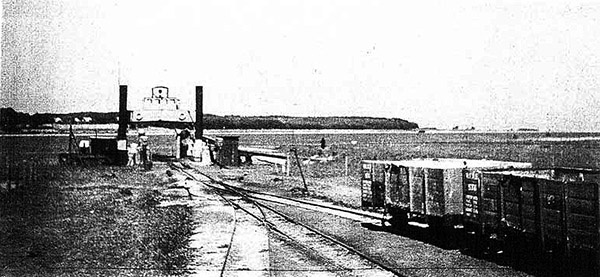
In Schiewenhorst a ferry crossing across the Vistula was organised [4] . Behind it a railway line was laid along the route: right bank of the Vistula – Nickelswalde (now Mikoszewo) – Pasewark (now Yantar) – Junkeracker (now Yunosino) – Steegen (now Stegna) – Stutthof (Sztutowo).
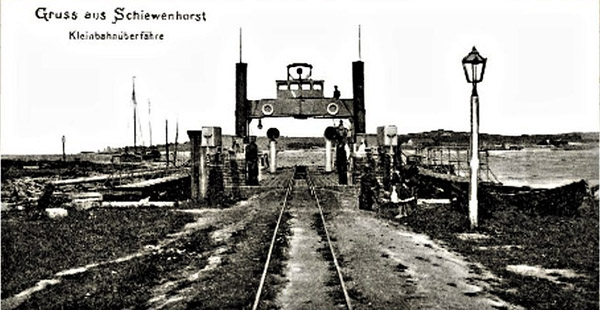
Some researchers of the history of this railway line believe that it was intended to be continued as a passenger line inside the Vistula Spit, to the summer cottage village of Kahlberg-Liep (now the aforementioned Krynica Morska). The railway was to become an alternative to shipping along the Frisches Haff (now the Vistula or Kaliningrad) Bay, which was used mainly by summer residents from Elbing (now Elbląg) and other cities adjacent to the bay. On 1 May 1906, the 15-kilometre line from Steegen to Tiegenhof was put into operation, with three swing bridges: in Fischerbabke (now Rybina), in Tiegenort (now Tuisk) and in Tiegenhof (Novy Dwór Gdański) over the rivers with the current names of Szkarpawa, Linawa and Tudz respectively. A significant expansion of the WKAG narrow-gauge railway network took place in 1913. Under the management of WKAG, this network operated until 1945.
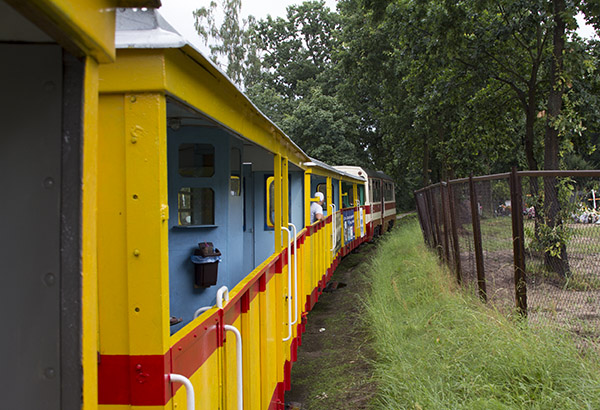
Narrow gauge railway to Kalberga-Lipá (Krynica Morska)
The construction of a narrow-gauge railway on the Vistula Spit was most likely quickly abandoned, given the unprofitability of such a line: as is well known, any corporation is focused only on its own benefits. In that part of the spit where there were several small fishing villages and a developing summer resort, there was no need at all to lay a regular hard road, much less a railway line. The tourist advantages of the peninsula did not speak in favor of a narrow-gauge railway, because the summer season was too short there.
In the rich agricultural Żuławy, where the narrow-gauge railway network was rapidly developing, freight transport was quite feasible. In addition, according to the Treaty of Versailles (1919), from January 1920 the Vistula Spit was divided into two parts by the border between the territory of the "free city" of Danzig and Germany, which did not have a positive effect on the inflow of investments. Kalberg-Lip was visited mainly by residents of Elbing, Königsberg (now Kaliningrad) and other cities on the Gulf coast who used shipping. Residents of Danzig wanted to relax in other resorts, for example in Zoppot (now Sopot). The need for a narrow-gauge line on this part of the Vistula Spit arose only at the end of World War II. There is an opinion (and the author of the article joins it) that the construction of the field narrow-gauge railway started by the Wehrmacht is not connected with the need to evacuate refugees from other areas of East Prussia, as some people interested in this topic believe. Although it could have been used for this purpose, it was supposed to serve the purpose of supplying and moving German troops temporarily stationed here.
This opinion is supported by the fact that the decision to begin laying the line was made at the same time that the troops of the 2nd and 3rd Belorussian Fronts of the Red Army had already clamped East Prussia in a pincer movement. As early as January 1945, units of the 2nd Belorussian Front (48th Army of Lieutenant General Nikolai Ivanovich Gusev) reached the coast of the Frisches Haff Bay in the area of Tolkemit (now Tolkmicko) and captured a bridgehead on the left bank of the Nogat River in the area of Marienburg (now Malbork), closing the encirclement of Thorn (now Torun) from the north. The arrival of Soviet troops on the coast of the bay meant cutting off Army Group Center from the German forces located west of the Vistula. The loss of Elbing by the Germans (10 February) and the flooding of Żuławy (in mid-March) meant that the only route for evacuation from East Prussia became the Vistula Spit.
The Wehrmacht sappers began laying a narrow-gauge (750 mm) field line on the spit at the end of January 1945. The work was carried out very quickly, because they planned to finish it by April 20. Perhaps by Hitler's birthday? The line (about 60 km) started in Stutthof, from the most north-eastern station of the WKAG sugar refinery narrow-gauge railway, and was supposed to run through Bodenwinkel (now Kąty Rybackie), Vogelsang (now Skowronki), Neue Welt (now Wydmy), Schottland (now Sosnovo), Pröbbernau (now Przebrno), via Schmirgel, Schellmühl, Mühlenfünftel (now Młyniska) to Kalberg-Lipp, then via Schmergrube, Vöglers (western part of Neukrug, now Ptashkovo), Neukrug (now Nova Karczma) to Narmeln (now part of the Russian Federation), from there via Grenz, Groß Bruch to Alttief and via Möwen-Haken, Kaddig-Haken, Lehmberg-Haken and Rappen-Haken to Neutief (?). In the Alttief – Neutief area there were German units, a military airfield, and the apartment of the Gauleiter and last Ober-President of East Prussia, Erich Koch.
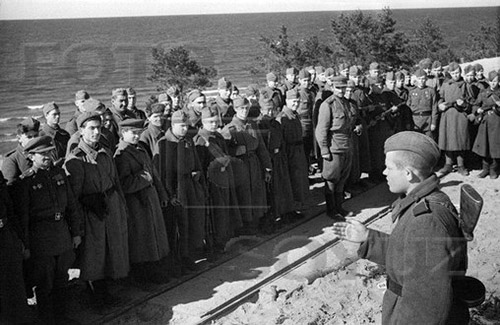
So, from Sztutowo the line went through the forest (about 5 km) to the east in the direction of Kąty Rybackie, from where it turned north, to the coast of the Gulf of Gdańsk. Then it went north-east in one direction, in places turning towards the mainland, along the ridge of the coastal dunes through Skowronki, Przebrno to Krynica Morskie (about 22 km from Sztutowo) and further to Nowa Karczma. In the area of Narmelno the line approached the Vistula Lagoon and then went along the road that leads to the village of Kosa (former Alttif). Probably, the Germans were able to finish laying the section of the line to Kaddig-Haken (about 50 km from Sztutowo), although it is possible that it was built to Alttif itself, but it was destroyed during the offensive of the 3rd Belorussian Front. The construction of the line on the spit was carried out using materials from dismantled sugar refinery railway lines and side farm tracks in the Żuławy area. The sections in the vicinity of Nowy Staw, Severnie Żuławki – Jeziornik, Gemlice – Wielkie Cedy – Koszwały, and the section Stegna – Rybina were dismantled. The finished sections of the railway line were transported on platforms to Sztutowo.

"Meanwhile, the Todt Organization ( Organisation Todt was a paramilitary construction organization operating in the Third Reich and named after its leader Fritz Todt (1891-1942). Among the objects built by the Todt Organization were highways (autobahns), Hitler's secret bunkers and various defensive structures, such as the Siegfried Line, the Atlantic Wall, etc. The Todt Organization made extensive use of prison labor in its work. - admin ) laid a series of transverse anti-tank ditches on the Vistula Spit, across which it was necessary to throw four steel bridges and three concrete underground canals for the railway line under construction. Railway sappers quickly leveled the surface of the so-called middle dunes, where they placed ready-made sections from dismantled sections." ( From the book by Roman Witkowski “ Koleje wąskotorowe na Żuławach”, 2009 , p. 49 ).
When digging anti-tank ditches, the Todt Organisation may have used prisoners from the Stutthof concentration camp for forced labour (author's assumption), because on 23 April 1945 there were still 4,508 prisoners there. During the construction or multi-day maintenance of the line in March and April 1945, the Wehrmacht used three four-axle diesel locomotives of the HF 200 D type [5] with a heavy-duty engine with a capacity of 200 horsepower. In the last days of the war, they were abandoned by the Germans on the side tracks of the Sztutowo-Mikoszewo route.
On April 17, 1945, units of the 3rd Belorussian Front broke through the German defenses in the northeast of the Vistula Spit and occupied the city of Fischhausen (now Primorsk), and on April 25, in cooperation with the navy, captured the fortress and port of Pillau (now Baltiysk). The Germans, who managed to cross the Pillau Strait, defended the Vistula Spit together with the remnants of the 4th Army until May 9, 1945. On May 1, the Germans lost Narmeln, on May 3 – Kalberg-Lipp, on May 5 – Pröbbernau, on May 7 – Vogelsang and Bodenwinkel.
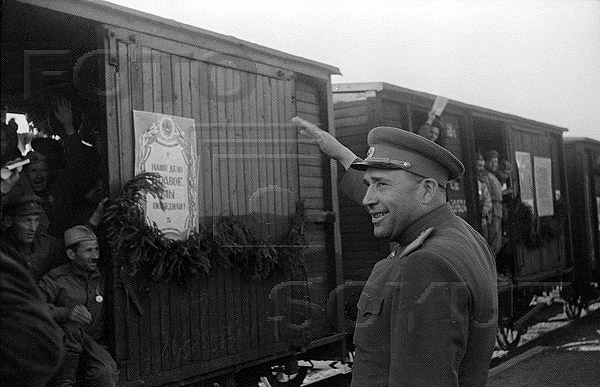
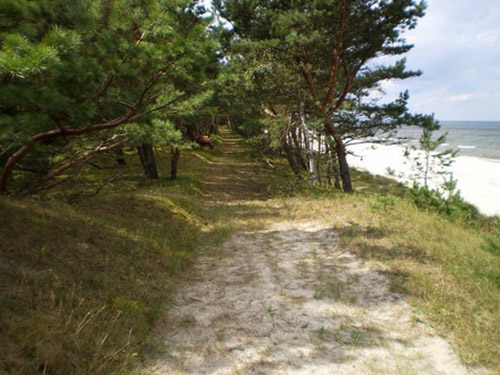
Narrow gauge railway to Lysitsa
For almost three years after the war, no one took care of the former German field narrow-gauge railway, with the possible exception of the Red Army soldiers who were temporarily stationed in Skowronki and Łysa Góra (Łysica from 1951, Krynica Morska from 1958). They completely dismantled the track section (approximately 13 km) that ran through Nowa Karczma to the border with the USSR, and removed the rails along with other property with the consent of the Polish authorities [6] . After the Soviet soldiers left the Polish section of the spit in 1948, Polish troops were stationed there, or more precisely, the navy and border guard troops (in January 1949, the 10th Border Battalion was transferred from Elbląg to Sztutowo). Since there was no rolled road leading to the base in Krynica Morska (then Łysa Góra) (there was a gravel road, an old postal route, but it had been destroyed in many places during the war and was unsuitable for the movement of heavy vehicles), the naval command approached the Polish State Railways (PKP) regarding the introduction of a narrow-gauge railway line on the Sztutowo – Łysa Góra route. In the spring of 1949, they began repairing the tracks damaged by the war and atmospheric phenomena, as well as rebuilding three destroyed viaducts over anti-tank ditches. Soon, individual freight cars with cargo for the fleet began to arrive in Sztutowo. Due to the shortage of diesel locomotives and the ban on the entry of steam locomotives, which was due to the obligation to protect the forests on the Vistula Spit, further delivery of goods was carried out by horse-drawn transport.
Since the line to Łysa Góra was not in operation, the three HF200D locomotives found were sent for repairs to the Kujawskie Sidings workshops in Krosniewice near Kutno. They later ended up in Warsaw, where, after being converted to 800 mm gauge, they served on the Warszawa Targowa – Targówek section. However, soon all of them had accidents and were transported to Karczew, to the workshops, where they could not be repaired. In 1951, these locomotives were sent back to the workshops in Krosniewice, but due to a shortage of spare parts, they could not be put into operation there either. From 1955 to 1958, all three locomotives remained scrap metal.
In 1950, two three-axle diesel locomotives, converted from 800 mm gauge to 750 mm gauge and designated L20 and L21, arrived in Sztutowo from the Jablonowska (Karchevska) railway. They were supposed to service the Sztutowo – Lysa Góra section, but they were constantly out of order and were often replaced by horse traction.
This line had fairly steep descents, sometimes exceeding the capabilities of horses. In 1950, the Navy opened a pavilion for the conservation and repair of batteries for military vessels in Łysa Góra. The narrow-gauge railway, especially with horse traction, became of little use to the Navy, as it was necessary to transport large batteries from and to the naval bases in Gdynia and Hel. Soon, also on the initiative of the Navy, an asphalt road was built from Łysa Góra to Sztutoł. This gave the military units that were temporarily stationed here the opportunity to use motor transport, and the narrow-gauge railway became unnecessary. Settlers gradually began to arrive in Łysa Góra – Łysica – Krynica Morska, which was said to be “at the edge of the world”. According to archival data, by April 1, 1948, 66 families (235 people) had settled there, and three reliable long-standing owners of farms remained. The local administrative unit was subordinate to the Gmina People's Council in Tolkmicko and had the status of a fishing settlement (in 1958, Łysica, which had 684 permanent residents, received the status of a village and a new name, Krynica Morska). Before the construction of the asphalt road, local residents had to sail to Tolkmicko on boats across the Vistula Lagoon for important business (regular boat trips were organized in 1949), and in winter they walked 7 km or rode sleds on the ice.
When the navy was discussing the possibility of closing down the narrow-gauge railway, the civil authorities probably raised the issue of introducing tourist trains on the Łysica-Sztutowo route. Despite the obvious advantages of the railway line, there was no talk of developed tourism in the future Krynica Morska, because the war-ravaged area did not even resemble the former resort. In addition, in order to introduce regular train service, the PKP had to obtain the consent of the military authorities, which was unrealistic, given that there were military installations there, shrouded in secrecy. An uncontrolled influx of civilians could allegedly pose a threat to their safety. Even before the 1970s, people arriving on the Vistula Spit were required to obtain permission to stay there. Residents had permanent passes valid for one year.
In September 1953, the PGR, on the orders of the Navy Command, finally began dismantling the line. For unknown reasons, a 3.5 km section in the forest between Krynica Morska and Nowa Karczma was dismantled only in 1965. Two years earlier, WKAG steam locomotive No. 5 (Tyl-1085), which had been heating the battery repair pavilion there since 1950, had been delivered on a flatcar to Lisiewo from Krynica Morska for recycling.
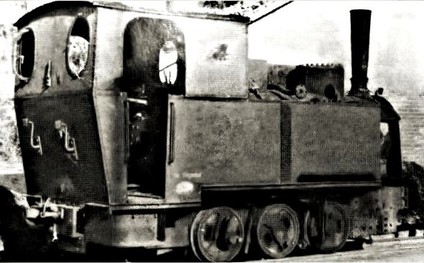
Notes:
[1] A now defunct fishing village near the Old Balga Strait (in the Baltiysk region of the Kaliningrad region).
[2] Now the village of Kosa.
[3] Żuławy (Vistula Żuławy; Polish: Żuławy Wiślane) is a lowland region in northern Poland, in the Vistula delta.
[4] The ferry crossing was put into operation somewhat late, because the train ferry Schiewenhorst II (Aegir in 1940–45, Świbno in 1948–59) was delayed on its way to Schiewenhorst due to low river water levels, and upon its arrival at the end of August 1905, on the very first day, due to improper operation, the pier was damaged, which led to the closure of the crossing until the damage was repaired. The ferry was built in 1903–04 in Bromberg (now Bydgoszcz) at a shipyard that was part of the Leopold Zobl engineering factory.
[5] HF - military field railway locomotive. The project was developed in 1939-1940 for the Wehrmacht. Four German factories were ordered 10 locomotives of this type. In total, including 1942, at least 35 were produced (Windhoff was able to build only 4 locomotives, the production of the rest was entrusted to Schwarzkopff. In addition, Deutz produced 5 locomotives of the HK 200 D 6.26 version, equipped with a different engine. At first, the HF200D was supposed to become the main locomotive of German railway companies, but this role was ultimately taken over by the lighter and less powerful HF130C. At the end of the war, several of these locomotives were in Poland.
Sources of photo materials:
fotosoyuz.ru
forum.dawnygdansk.pl
